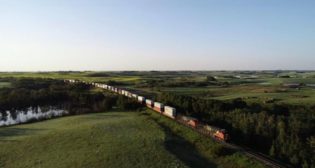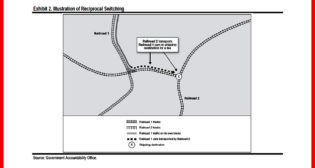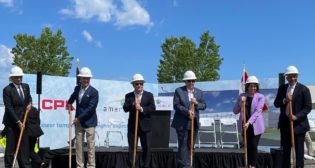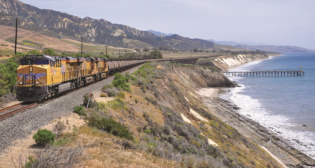
Class I Participation in FRA C3RS Still Pending
Written by Marybeth Luczak, Executive Editor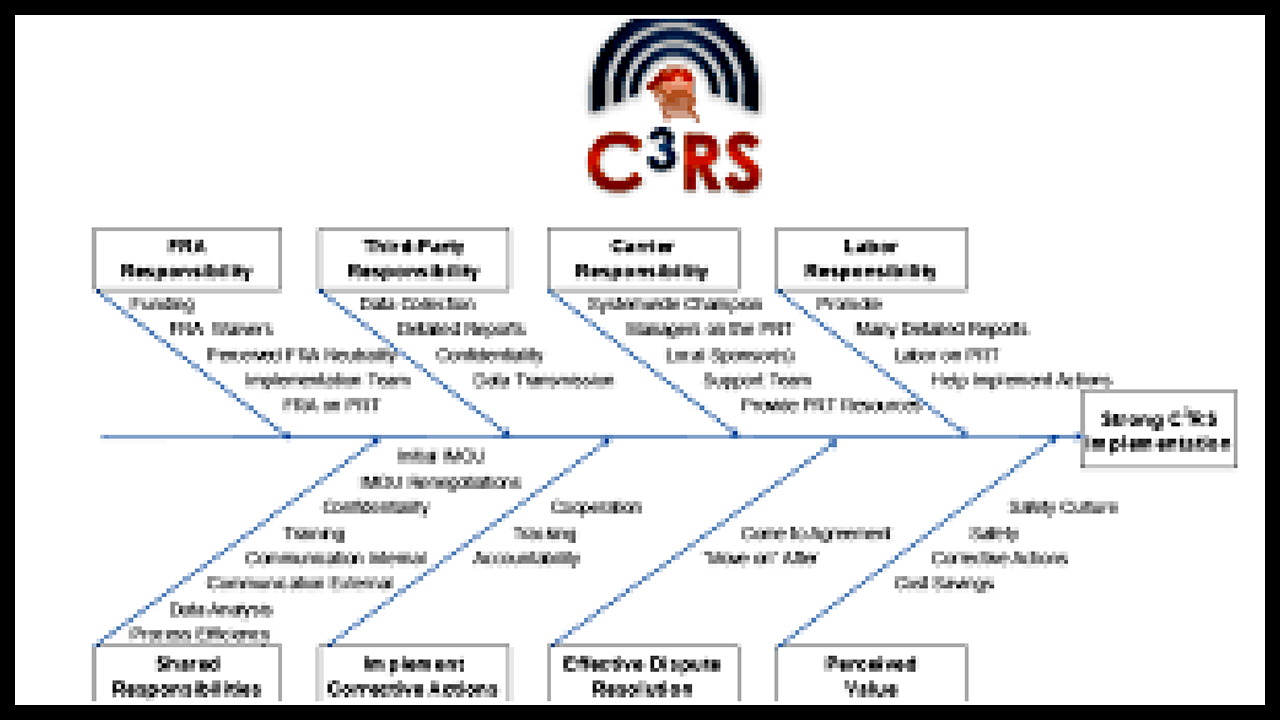
The Transportation Trades Department of the AFL-CIO has written letters to all six Class I railroads (download below) urging them to join the Federal Railroad Administration’s (FRA) voluntary Confidential Close Call Reporting System (C3RS), which the railroads, through the Association of American Railroads (AAR), committed to doing in March but are still working with FRA to make program adjustments they feel are necessary.
AAR President and CEO Ian Jefferies explained the railroads’ commitment in a March 2 letter to U.S. Transportation Secretary Pete Buttigieg, who in Feb. 27 letters to the individual railroads (seven at the time, as Canadian Pacific and Kansas City Southern had not yet merged) requested that they join C3RS, following the Norfolk Southern (NS) train derailment and release of hazardous materials in East Palestine, Ohio.
“The industry absolutely shares your commitment to establishing effective mechanisms to help prevent future accidents like the derailment in East Palestine,” wrote Jefferies. “You will hear from each of the railroads individually in response to your letter as well. I write to provide important history and context regarding railroad use of close call reporting, hopefully to pave the way for working with you, FRA, and our employees to develop an even better system.
“[U]nion Pacific and Canadian Pacific … actually initiated the first C3RS pilot programs with FRA in 2007. All Class I railroads have longstanding programs in place that allow employees to provide confidential feedback on safety issues. These programs range from establishing and using anonymous reporting hotlines to processes that incorporate peer review teams and root cause analysis, much like C3RS. The railroads value receiving this type of close call information in a timely manner because it allows them to act quickly and proactively to address safety issues before they lead to an accident. The Class I railroads expect to continue to operate these internal confidential reporting programs in addition to their voluntary participation in C3RS.
“As you know, some railroads currently participate in FRA’s C3RS program while others that formerly participated dropped out of the program because it was viewed as less effective than their existing programs. We want to work with FRA to make the C3RS program better and more effective. In that spirit, we are identifying certain aspects of the current FRA program that have historically led to railroads declining to participate in favor of their own internal programs. We believe these matters can and should be improved. Our interest is in seeing a streamlined process that maintains important confidentialities for both reporting employees and carriers while also efficiently sharing high quality safety information so that railroads can quickly take appropriate action to address legitimate safety issues. More specifically, areas for improvement include:
- “Quality of reporting: The information provided by employees is currently routed through NASA’s reporting system. As noted by the U.S. Government Accountability Office (GAO), often the information received is insufficient for railroads to act on because it does not contain enough detail to develop practical corrective actions. NASA staff, who are understandably not familiar with railroading, face difficulties with gathering the needed additional information. We believe these issues can be easily addressed.
- “Speed of reporting: Feedback on a close call that did not result in an accident takes a long time to reach the railroad. Indeed, NASA’s procedure requires it to wait at least 30 days before it reports to the railroads, which makes a quick response impossible. This, too, should be addressed.
- “Confidentiality: There are concerns that FRA may have not always kept close call reporting data confidential. Protocols that protect the confidentiality of the information will ensure continued and robust participation. The Federal Aviation Administration has such protocols in its Aviation Safety Reporting Program (ASPR), and we believe similar protocols should be adopted by FRA.
- “Addressing repeated unsafe conduct: Typically, the person reporting a close call is exempt from the internal disciplinary process that would otherwise apply in the case of a violation of safety rules. AAR recognizes that protection as a necessary feature of the program in the vast majority of circumstances. However, the rare situation in which an employee is misusing the system to prevent his or her unsafe decisions or actions from being addressed by the railroad, the program should permit the railroad to address that repeated misconduct with the employee. This is needed for the safety of the railroad, its other employees, and the public.
- “Sharing of information: To the extent the information collected by the program is useful in improving safety practices and policies, it should be shared with the wider industry and in a timely fashion. GAO has made this recommendation, and AAR agrees.
“As you know, FRA has already scheduled a Railroad Safety Advisory Committee (RSAC) meeting for March 14, 2023 to address this program. AAR members look forward to participating in that meeting to provide their perspectives on the opportunities and challenges related to close call reporting. We are committed to continuing the 20-year trend of continuous safety improvements in the rail industry. We look forward to working with you and with FRA on these critical issues.”
AAR at the same time pointed to recent FRA safety data as confirming that “U.S. railroads continue to maintain a strong safety record. The train accident rate is down 28% since 2000, and the past decade was the safest ever.”
The association highlighted the following “notable statistics,” calculated per million train-miles:
- “The Class I railroad main line accident rate is at an all-time low and down 49% since 2000. For all railroads, that rate has declined 44% since 2000.
- “For all railroads, the derailment rate is down 31% since 2000, but despite that longer-term positive trend, it was up by 3% year-over-year (from 2021).
- “Track-caused accidents are down 55% since 2000 and are at their lowest-ever rate across the entire rail industry.
- “Equipment-caused accidents were down 21% since 2000 but increased by 15% compared to 2021.
- “Per Class I railroad employee, the casualty rate has dropped 63% since 2000 and is at an all-time low.
- “Per carload, the hazardous materials (hazmat) accident rate is down 78% since 2000 and the lowest ever based on preliminary Bureau of Explosives data.
Jefferies said in a statement that “we all saw the devastating impact a train derailment can have on a community [following the Feb. 3 derailment], and we are committed to continuing our industry’s efforts to prevent what happened in East Palestine from happening elsewhere. This data makes clear that our employees’ strong safety culture paired with the sustained, disciplined investments in maintenance and technologies that target the primary causes of accidents deliver meaningful safety results. There is more work to do, but FRA’s data clearly reflects railroads’ steadfast safety commitment.”
TTD: Don’t Let C3RS Negotiations Become a ‘Delay Tactic’
In its letters to the Class I’s, TTD wrote that it has been nearly six months since AAR made its public commitment and “none of the Class I railroads have voluntarily joined the program.” While the union said it appreciated “the ongoing discussions between industry and labor regarding revisions to the current program,” it cautioned against “these negotiations becoming a delay tactic.”
TTD reported that “federal data shows that approximately every three hours, there is a reportable injury” and that “[a]pproximately every eight hours, there is a derailment that reaches the FRA’s reporting threshold of $11,500 in damage.” In other words, the union said, “three times every day there could be another East Palestine, but we believe this [C3RS] program could help mitigate such future disasters.” It pointed out that since implementation of a similar program in the aviation industry, the fatality rate decreased 83% in less than a 10-year span. “We believe that implementing the program fully in the freight rail industry can similarly improve safety,” TTD said. “Rail workers are the eyes and ears of the system. Yet worker perspectives about current and prospective safety incidents are not fully leveraged at the moment. We believe the Confidential Close Call Reporting System can help leverage these vital worker perspectives and improve safety. … We appreciate the increased collaboration between labor and industry in recent months and hope we can continue onward in the spirit of mutually-beneficial cooperation to deliver on rail safety for America.”
In a statement to The New York Times, which published an Aug. 11 report about the railroads and the C3RS program, Pete Buttigieg said: ”Too often, after a major rail incident, an immediate public call for better safety practices has eventually given way to industry pushback and inaction. That must not happen this time.” Nearly six months after their March commitment, he noted that “[i]t is past time for them to keep their promise.”
According to the Times, AAR and the Class I’s have been working with FRA to agree on program participation terms, and a working group of FRA’s Railroad Safety Advisory Committee—established before the Feb. 3 derailment to look at program expansion—has discussed the potential addition of railroads.
“One idea under consideration is for the companies to participate in a pilot program, but a consensus on how to move forward has yet to be reached, according to government and industry officials,” the Times reported.
A working group member, Brotherhood of Locomotive Engineers and Trainmen (BLET) Vice President Vincent G. Verna “said that although the freight rail companies continued to express interest in being part of the program, there were still disagreements over key issues, including protecting workers from discipline,” according to the paper. “The freight railroads ‘do not want to relinquish their ability to discipline their employees who report something if they think there’s a rule that has been violated,’ Mr. Verna said. ‘They want to be able to retain the ability to discipline.’
“Mr. Verna said that from the perspective of workers, maintaining anonymity is critical for the program’s success. If railroad employees have reason to fear punishment for reporting safety violations, they will not use the program, he said.”
Rail Passengers Association President and CEO Jim Mathews, another working group member, told the Times that program effectiveness depends on railroads embracing a nonpunitive approach. “The position that the freight railroads have taken is both unfortunate and unwise,” he said. “If they truly want a safer system, then punishment and discipline cannot be the only tool in your toolbox.”
According to the Times, AAR points out that the railroads’ existing programs “are more effective and efficient than the federal program” and “that workers could abuse the federal program by reporting incidents that are already known to their railroads to insulate themselves from punishment.”
AAR spokeswoman Jessica Kahaek told the Times that “[y]ou risk creating a paradigm that weakens the importance of following policies and procedures.”
Program participation is “a common-sense action to advance safety,” FRA spokesman Warren Flatau said in a statement to the Times. “Referring to the major freight railroads, he added that the agency ‘has and will continue to engage in good-faith discussions with each Class I railroad to secure their participation in this safety program.’”
NS met with FRA in May to discuss the program and will continue discussions this month, railroad spokesman Connor Spielmaker told the Times, noting “[w]e are making good progress toward operationalizing our membership in the program.”
C3RS Not as Clear-Cut as It Seems
William C. Keppen Jr., one of three original Rail Safety Advisors (RSAs) who helped to establish the FRA-sponsored and Bureau of Transportation Statistics (BTS)-run C3RS program, in March wrote a Railway Age editorial about the challenges the original program faced and what happened when it transitioned to a National Aeronautics and Space Administration (NASA)-run program. A retired BLET Vice President and third-generation locomotive engineer at BNSF and predecessors Chicago, Burlington & Quincy and Burlington Northern, Keppen is an independent transportation advocate with experience in fatigue countermeasures programs.
In his editorial, Keppen expected the following challenges to an expanded C3RS program:
“Real buy-in and commitment from some railroad management figures and some labor representatives.
“Expenses, including the cost of engaging a third party to conduct interviews and write incident reports to be handle by members of Peer Review Teams (PRTs).
“The composition and authorities delegated to a PRT.
“Reaching consensus on whether any reporting employee could be held accountable for reported incidents.
“What incident report collection should be conducted by NASA, or if that should be handled directly by participating railroads, individually.
“If individual railroads handle their own incident reports, what should be passed on to NASA, so the industry at large may learn from what has been reported and what corrective actions have been implemented to prevent future occurrences.”
According to Keppen, the C3RS selected BTS to run the original program, and three RSAs, “including me, were hired to review incoming C3RS reports and conduct interviews with those who were reporting incidents. That part of the process was virtually eliminated when C3RS was transferred to NASA. Look for an easy solution, hire an independent third party familiar with railroading, and conduct those interviews. Find out why the incident happened, not just what happened.”
He pointed out that when BTS was running the program, interviews “were conducted daily, as needed. Reports were written and reviewed by members of the RSA team, and individual railroad PRTs met on a monthly or as-needed basis to evaluate BTS C3RS reports and formulate corrective action recommendations.” Keppen wrote that if “speed and quality of information obtained are matters of concern, as they should be, this is one viable solution.”
Additionally, Keppen said, “FAA and NASA really do not have the same statutory authority as BTS has to protect data.” He pointed out that “[w]e, the RSAs, warned FRA and participating railroads of that, when FRA was suggesting migrating C3RS from BTS to NASA, but the move went forward, nonetheless. This will likely be the most difficult issue that management and labor will have to address, as they attempt to establish their own C3RS reporting programs.”
Keppen suggested “use of the existing NASA C3RS form to maintain uniformity, which could be processed on-property, including interviews and PRT reviews and recommendations, which could then be sent to NASA, in de-identified form for cataloging and publishing.”
Additionally, Keppen referred to AAR’s March letter, in which Jefferies wrote that the association “recognizes that protections are a necessary feature of the [C3RS] program,” and that railroads feel these programs should “permit the railroad to address repeated misconduct with the employee.” To this, Keppen responded: “Well, so much for confidentiality. Try selling that to labor, while attempting to establish your on-property C3RS reporting programs.”
Keppen, like TTD, wrote that he “would hate to see something as important as establishing viable C3RS programs tied up in lengthy RSAC deliberation and debate, which might also involve a working group, as often happens at RSAC. The basic functions and framework for C3RS programs were established long ago, and need not be changed.
“To establish programs on individual railroads, management will have to identify and meet with the appropriate labor leaders, of the crafts they choose to involve in their programs. While working through the details needed to develop a mutually agreeable program, be mindful of the MOU (Memorandum of Understanding), Key Elements of the Close Call Reporting System. Your assignment, should you choose to accept it, is to recognize and embrace the very foundation of such agreements: mutual agreement. Without it, railroads will not be able to establish a C3RS reporting program, because the key and operative word for these programs is voluntary.”
